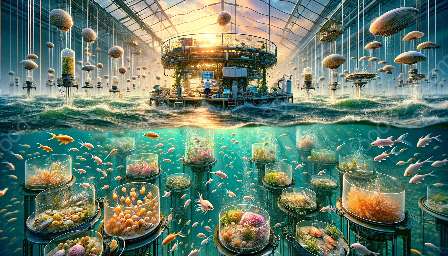Shellfish reproductive biology is a captivating and essential aspect of shellfish biology and aquaculture. Understanding the reproductive processes of shellfish is crucial for sustainable aquaculture practices and the management of wild populations. This comprehensive topic also plays a significant role in seafood science, affecting the quality and availability of shellfish for human consumption.
The Fascinating World of Shellfish Reproduction
Shellfish, including various species of mollusks and crustaceans such as oysters, mussels, clams, shrimp, and crabs, exhibit a diverse array of reproductive strategies and life cycles. These marine and freshwater organisms have evolved unique mechanisms to ensure their survival and successful reproduction in often challenging and dynamic environments.
Reproductive Strategies and Life Cycles
The life cycles of many shellfish species are characterized by complex reproductive strategies, which can include both sexual and asexual reproduction. Some shellfish, such as oysters and mussels, undergo a process known as broadcast spawning, releasing their eggs and sperm into the water column for external fertilization. In contrast, other species, like certain types of shrimp and crabs, engage in internal fertilization, where the female retains the eggs until they hatch as larvae.
- Spawning: Spawning, the release of reproductive cells, is a crucial event in the reproductive process of shellfish. Factors such as environmental cues and water temperature often influence the timing and success of spawning, making it a subject of significant interest in both aquaculture and natural resource management.
- Sexual Dimorphism and Gonadal Development: Understanding the differences between male and female shellfish, as well as the development of their reproductive organs, is vital for monitoring and controlling the reproductive output of populations in aquaculture settings.
Significance in Shellfish Biology and Aquaculture
The study of shellfish reproductive biology holds immense importance in the fields of shellfish biology and aquaculture. Researchers and aquaculturists aim to comprehend the intricacies of shellfish reproduction to enhance the success of breeding programs, optimize larval rearing techniques, and develop sustainable methods for population enhancement and wild stock management.
Key Aspects of Shellfish Reproductive Biology in Aquaculture
Genetic Diversity and Selective Breeding: Effective management of shellfish populations often involves understanding and maintaining genetic diversity through selective breeding programs. Knowledge of the reproductive biology of shellfish species is essential for developing strategies that enhance desirable traits and resistance to diseases.
Larval Rearing and Spat Production: The successful rearing of shellfish larvae and the production of spat, the juvenile shellfish, are highly dependent on a comprehensive understanding of the reproductive biology, including larval development and feeding requirements, of various shellfish species.
Relevance to Seafood Science
The intricacies of shellfish reproductive biology have far-reaching implications for seafood science. This field encompasses the study of shellfish as a valuable food source, focusing on their nutritional qualities, safety, and sustainability.
Impact on Seafood Availability and Quality
Being well-versed in the reproductive biology of shellfish enables seafood scientists to predict and manage fluctuations in shellfish populations, offering insights into the availability and quality of shellfish products. Understanding the reproductive cycles and factors influencing shellfish reproduction directly contributes to the sustainable management of shellfish as a vital seafood resource.
In conclusion, delving into the realm of shellfish reproductive biology offers a multifaceted understanding of the intricate mechanisms that drive the reproduction, growth, and sustainability of these aquatic organisms. The encompassing nature of this topic makes it an indispensable aspect of shellfish biology, aquaculture, and seafood science, playing a pivotal role in ensuring the continued availability and quality of shellfish as a valuable resource for human consumption.

